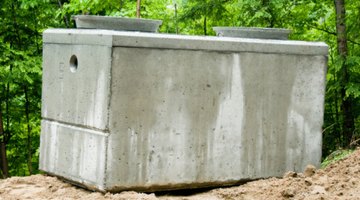How to Seal a Cistern
Rain and drinking water can be stored in a variety of contraptions, with one of them being a cistern. You must waterproof your cistern with a specialized sealer before you can store water in it. The waterproof lining is what separates a cistern from a well.

Cisterns range in size, from a few liters to large-capacity ones. Sealing your cistern can be accomplished within a day or two, but a helpful volunteer may speed up the process. The drying and curing takes the longest time allotment, however.
Things You Will Need
- Wire brush
- Paint remover or muriatic acid
- Water
- Primer, if needed
- Food grade sealing product, such as Wel-Cote Water Sealer or Ames Vapor Barrier
- Masonry brush, if needed
- Paint brush or roller
- Fine-mist spray nozzle and hose
-
Drain all water from your cistern, if it has been previously used.
-
Clean your cistern surface area. Remove any dirt, oil or debris with a wire brush. Paint and cement paint must also be removed with paint remover or a 20% strength muriatic acid solution that has been allowed to sit on the surface for 1 to 4 hours. Wear gloves and protective eye gear when doing this. Thoroughly clean the entire area with water afterward.
-
Fix any cracks or damaged areas, if needed. Allow any cement or other products to dry thoroughly before proceeding.
-
Read your sealer product instructions thoroughly before using. Wel-Cote Water Sealer and Ames Vapor Barrier are a couple of different cistern sealer products you can use.
-
Apply a primer to the surface if your chosen sealer recommends this. Use a paintbrush to apply it and allow it to dry.
-
Mix your sealing product according to the directions. Each product will be different. You will most likely add a certain amount of sand to the mixture for the first coat.
-
Apply your first coat of sealer to the entire damp, but not soaking, cistern surface. Use a masonry brush to apply your sealer to rough areas or a full paintbrush or roller for smoother areas. Make sure you generously coat the whole area.
-
Allow the sealer to dry between coats.
-
Use a fine-mist spray nozzle on your hose to re-wet the cistern surface. Apply a second coat of sealer. The second coat most likely will not require sand additives.
-
Allow the sealer to cure overnight. After it is dried, it should be hard and non-chalky. You must make sure it is completely cured before filling the cistern with water. Otherwise you may be able to taste the sealer in the water that you extract from the cistern.
Tip
If you plan on storing drinking water in your cistern, use food-grade sealer and cement for this project.
The Drip Cap
- Rain and drinking water can be stored in a variety of contraptions, with one of them being a cistern.
- Remove any dirt, oil or debris with a wire brush.
- Allow any cement or other products to dry thoroughly before proceeding.
- Wel-Cote Water Sealer and Ames Vapor Barrier are a couple of different cistern sealer products you can use.
- Allow the sealer to dry between coats.
- Use a fine-mist spray nozzle on your hose to re-wet the cistern surface.
- You must make sure it is completely cured before filling the cistern with water.
References
Photo Credits
- Jupiterimages/Photos.com/Getty Images
- Jupiterimages/Photos.com/Getty Images
More Articles



